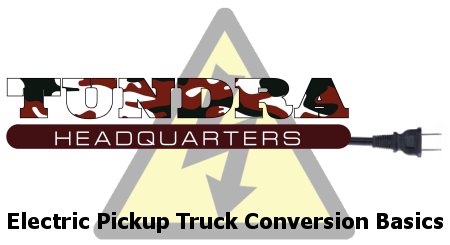Gas to Electric Pickup Truck Conversion Guide – The Basics
Jason Lancaster | Jun 10, 2009 | Comments 4
There are a wide range electric conversion options for truck owners interested in going full electric. Here are the basics:
Truck type: Until recently, smaller trucks were preferred over their larger cousins due to weight issues, but advances in battery technology had enabled even full-size drivers to take advantage of an completely emissions-free ride.

Electric Truck Conversion - a "short" guide.
Battery Options: Inexpensive conversions typically use lead acid or absorption glass mat (AGM) batteries – just like the battery under your truck’s hood right now. It’s not uncommon for amateur conversions to fill the truck bed with as many as two dozen 6 or 12 volt lead-acid or AGM batteries to go full electric. If you want to preserve your pickup bed for hauling (go figure), batteries can also be located in the passenger compartment, under the hood, or anywhere you can make them fit.
If money is no object, then nickel / metal hydride (NiMH) batteries, which are identical to those used in vehicles like the Toyota Prius, can be used for conversions. If money is really no object (and that’s not just an expression), then ultra-high end lithium ion (Li-ion) batteries can be used. Both Li-ion and NiMH batteries may require special cooling systems, but they are lighter than lead-acid and AGM batteries and take up far less room in a typical conversion.
Battery Location: For full-size trucks, it’s best to mount the batteries between the frame rails in order to make sure that the added weight doesn’t negatively impact vehicle stability. While removing the gasoline engine and transmission saves some pounds, it is not unusual for an electric conversion to add thousands more thanks to the weight of the batteries.
The propulsion system: Once the power storage needs are squared away, it’s time to talk propulsion. The electric motor itself is usually installed where the original engine used to be. In addition to an electric motor, a power controller – which essentially acts as a throttle between the energy contained in the battery packs and the motor – is a key component. Upgraded, conductive wiring between all components and vehicle accessories is often needed as well. Special instruments to monitor the system – like the battery pack temperature(s), remaining charge, rate of charge/discharge, etc. are necessary as well. Finally, a charging system designed for the battery system is also required.
Some may choose to install more than one electric motor, or even locate the motors at the wheels themselves. More complex installations can even include devices which capture the kinetic force released during braking and use that to help keep the batteries charged while driving.
Converting a pickup from gas-power to electric is an achievable task. It does require a certain set of skills, however, which is why many are turning to professionals for complete, warranty-covered installations which use the latest technology to keep things as reliable as possible. As far as the financial benefits and drive-ability sacrifices…let’s just say that your truck isn’t going to drive near as far between “fill-ups”, and all those batteries are going to reduce your payload and tow rating.
Still, for a lot of truck owners, it beats going to the gas station.
Search terms people used to find this page:
- tundraheadquarters
Filed Under: Tundra Hybrid


I’ve been reading stories on the web about how difficult it is to get parts for EV conversions. Any suggestions on purchasing parts for EV conv?
Ann – I don’t have any specific sites I can recommend, but we did another article with some links here https://www.tundraheadquarters.com/blog/2009/07/08/electric-pickup-truck-conversion-links/
Isn’t the propane or natural gas would do a great job for less?
I think it’s probably a little easier and a little less expensive (pretty sure there’s a tax credit for doing one of those conversions too), but it’s not as neat. I think anyone who has actually converted their own car to electricity will tell you it was just as much about having fun as it was anything else.